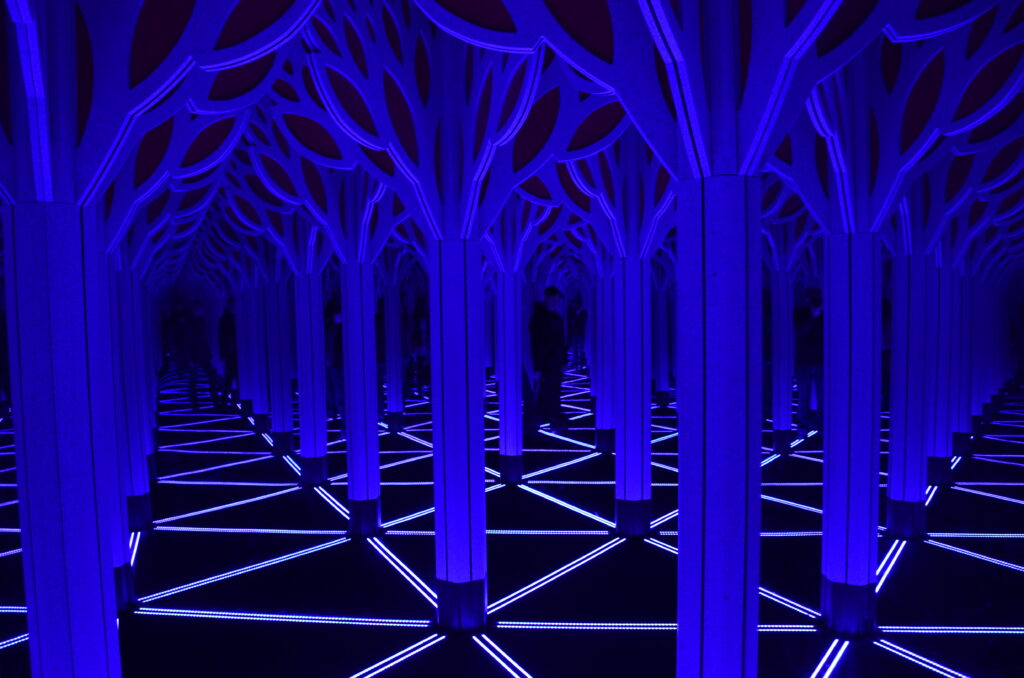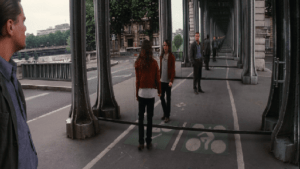
Mirror Mazes are amazing. They produce intricate optical illusions of various grandeur. Irrespective of the complex structures they produce, all the mirror mazes are based on the simple Physics of geometrical optics, i.e. the laws of reflection. Two plane mirrors, inclined to each other at some angle, creating multiple images of an object placed in between, is the building block of all mirror mazes. In this post, we shall understand how and why multiple images of a single object are formed by a set of two plane inclined mirrors.
The Problem
What is the maximum number, $N$, of images of an object placed between two inclined plane mirrors can an observer see at once?
As we shall see later in this post, that the number of images that can be seen by an observer depends, in general, on the following three parameters:
- the angle between the inclined mirrors
- the placement of the object between the mirrors
- the position of the observer
Since we are only interested in the maximum possible number of images that the observer can see at once, we can relieve our concern about the position of the observer, with the assumption that our observer understands the following rule:

In the forthcoming explanation, also while making the mathematical formulations, we shall consider the other two factors.
The Setup

As shown in the diagram above, we have taken two plane mirrors ML (left mirror) and MR (right mirror) inclined to each other at an angle $\theta$. An object P is placed between them. The mirrors meet each other at O, If we draw an imaginary line from O to P, then OP makes angles $\theta_1$ with ML and $\theta_2$ with MR respectively.
$\boxed{\theta = \theta_1 + \theta_2}$
OP is our reference line, with respect to which we are going to assign angular positions of all images on the respective mirrors.
The Approach
Image tracing in geometrical optics is mostly done using rays starting from the object. We try to trace these rays as they reflect at various points on the mirrors or refract through the lenses. In the case of inclined plane mirrors, each mirror produces a direct image of the object. Then each of these images acts as an object for the other mirror and creates another image and so on. Using the method of ray tracing demands extraordinary fastidiousness. It is also very prone to confusion and errors. Fortunately, there is an easier and much simpler method. We shall use the angular separation of each image in a mirror from a reference line. But let us first convince ourselves that the angular separation method is nothing but the laws of reflection stated differently.

From the image above, we can see and understand that if the object to origin line OP makes an angle $\theta$ with a plane mirror, its image to origin line OP’ too will make an angle $\theta$ with a plane mirror in the opposite direction. This is our approach.
However, there are six principles of reflection we must bear in mind.
The Six Principles
- If two plane mirrors are inclined to each other with an angle more than or equal to $180^\circ$, an observer can see only one image of an object placed between the mirrors. That’s because, there will be only one mirror that will face the object at any given time.
- If the mirrors are at exactly $180^\circ$ with each other, they are effectively just one mirror. Thus any object placed in front of them (or it), shall have only one image.
- If the mirrors are at exactly $0^\circ$, each image in one mirror will act as an object for the second and so on. This will create infinitely many images of an object placed between them.
- The object angular distance from the mirror is equal and opposite to the image angular distance from the mirror.
- An observer, in order to see the image of an object placed in front of a mirror (or its extended imaginary part), must be in a line of sight with the image passing through the actual mirror.
- All the images formed by a pair of inclined plane mirrors lie on a nonrepeating circle (with total angle $\alpha \ |\ 0\leq\alpha\leq360^\circ$) centred at the origin (point of intersection of the mirrors) and with a radius of the length of the line joining the object to the origin.
The Mathematics
Now we are ready to discuss the math behind the image formation due to the two inclined plane mirrors. We shall cover all possible cases systematically.
The Beginning
Let us start by using the diagram in our setup and draw the first image in each mirror.

We name the first image in ML as PL1 and the first image in MR as PR1. Here we can observe that PL1 is at an angular distance of $2\theta_1$ from the reference line OP. Similarly, PR1 is at $2\theta_2$ from OP. Thus,
| The angular separation between the first pair ($n=1$) of images is: $2\theta_1+2\theta_2=2\theta $ |
Now, PL1 will act as an object for MR and produce an image PR2 while PR1 forms PL2 in ML. The following diagram shows this development.

PL2 will be at an angular distance $2\theta_2$ from PL1 and PR2 at an angular distance of $2\theta_1$ from PR1. Thus,
| The angular separation between the second pair ($n=2$) of images is: $2\theta_2+2\theta_1+2\theta=4\theta $ |
Now, PL2 will act as an object for MR and produce an image PR3 while PR2 forms PL3 in ML. The following diagram shows this development.

PL3 will be at an angular distance $2\theta_1$ from PL2 and PR3 at an angular distance of $2\theta_2$ from PR2. Thus,
| The angular separation between the third pair ($n=3$) of images is: $2\theta_1+2\theta_2+4\theta=6\theta $ |
All the above three developments are shown in the diagram below.

This shows that the $n^{th}$ pair will have an angular separation of $2n\theta$ between its images.
Such pair formation will keep on happening as long as $2n\theta<360^\circ$. The sequence of developments is summarized in the table below.

The End
Now, what happens when $2n\theta\geq360^\circ$?
To answer this question, let us be a bit more mathematically organized.
Let’s say that
$\frac{360^\circ}{\theta}=k+\delta \ \ [(k\in\mathbb{N})\land(0\leq\delta<1)]$
This means when we divide $360^\circ$ with $\theta$, we may get some rational number $k+\delta$ in which $k$ is the whole number part and $\delta$ is the decimal part. Now, depending upon the values of $k$ and $\delta$, in conjunction with the values of $\theta$,$\theta_1$, and $\theta_2$, we can find the value of $N$, the maximum number of images an observer can see at once.
If $2\geq k+\delta$, then $\theta$ is greater than or equal to $180^\circ$. As we have discussed before, in such cases, $$N=1$$.
If $2<k+\delta<<\infty$, then there are various situations. Let’s go through them one by one.
- $$(k=2n\ [n\in\mathbb{N}])\land(\delta=0)$$In this case, the entire $360^\circ$ is evenly divisible by $\theta$. So, the $n^{th}$ pair will create two images that will coincide and instead of getting 2 images from the $n^{th}$ pair, we get just 1. Thus $$\boxed{N=k-1}$$
- $$(k=2n\ [n\in\mathbb{N}])\land(\delta\neq0)$$In this case, after the $n^{th}$ pair has been formed, $\delta\theta$ will remain out of $360^\circ$. Since $\delta<1$, $\delta\theta<\theta$. In order for a new pair of images to be formed, we need $2\theta$ and we don't have that much space. So, let's see if any single image can be formed. Here there are three possibilities that depend on the angular position of the object.
- $$\delta\theta<min\{2\theta_1,2\theta_2\}$$Since we do not have enough space for another image by either mirror, $$\boxed{N=k}$$
- $$\delta\theta=min\{2\theta_1,2\theta_2\}$$A new image will be formed by the mirror that needs the minimum of $2\theta_1$ and $2\theta_2$ in its image forming sequence, but this new image will coincide with an existing image from the $n^{th}$ pair. Thus, $$\boxed{N=k}$$
- $$\delta\theta>min\{2\theta_1,2\theta_2\}$$A new image will be formed by the mirror that needs the minimum of $2\theta_1$ and $2\theta_2$ in its image forming sequence.Thus, $$\boxed{N=k+1}$$
- $$(k=2n+1\ [n\in\mathbb{N}])\land(\delta=0)$$In this case, the entire $360^\circ$ is divisible by $\theta$ but only $n$ (even) pairs (or $2n$ images) will be formed out of $360^\circ-\theta$. Now let’s see if a single image can be formed by either mirror. Here there are two possibilities that depend on the angular position of the object.
- $$\theta_1=\theta_2$$If the object is placed on the angle bisector between the mirros, then, $2\theta_1=2\theta_2=\theta$. Thus either mirror can form the last single image. However, no matter which mirror does, the final single image will coincide with an image from the $n^{th}$ pair. Hence, $$\boxed{N=k-1}$$
- $$\theta_1\neq\theta_2$$In this case, let’s say $\theta_1<\theta_2$. This also means that $\theta_1<\frac{theta}{2}$. This also means that $2\theta_1<\theta$. Thus which ever mirror requires $2\theta_1$ angle for its next in sequence image, will for an image that will not coincide with any of the existing images. The same condition applies if, $\theta_2<\theta_1$. Thus, $$\boxed{N=k}$$
- $$(k=2n+1\ [n\in\mathbb{N}])\land(\delta\neq0)$$In this case, after the $n^{th}$ pair has been formed, $(1+\delta)\theta$ will remain out of $360^\circ$. Since $\delta<1$, $(1+\delta)\theta<2\theta$. In order for a new pair of images to be formed, we need $2\theta$ and we don’t have that much space. So, let’s see if any single image can be formed. If $\theta_1=\theta_2=\frac{\theta}{2}$, then $2\theta_1=2\theta_2=\theta$. Since $\theta<(1+\delta)\theta$, any of the mirros can form the next image. However, the observer can be in the line of sight of only one of these two at once. If $\theta_1<\theta_2$ and thus $\theta_1<\frac{\theta}{2}$, $2\theta_1<\theta$. So, whichever mirror needs $2\theta_1$ for its next in sequence image, will form an extra image. Albeit, the observer needs to adjust his position to see this image. Simiar outcome is obtained if $\theta_2<\theta_1$. Hence, For all conditional relations between $\theta_1$ and $\theta_2$, $$\boxed{N=k}$$
Although it is ubiquitous, let’s, for fun sake, consider the case where the two mirrors are facing completely parallel to each other. Since any new image in either will act as an object for the other and form a new image and so on, there will be infinitely many images. According to the mathematical framework that we have established for this problem, we can say,
$\theta=0\implies\frac{360^\circ}{\theta}\to\infty\implies k+\delta\to\infty$
Thus, $$\boxed{k+\delta\to\infty\implies N\to\infty}$$
This can be seen in a famous movie scene from Inception ?

Experiments
I also conducted some key experiments to verify the validity of my theory. The pictures are given in the gallery below.
Conclusion
This marks the end of this post that covers all possible cases of image formation by two inclined plane mirrors. The designers of awe-inspiring mirror mazes use this knowledge to build their worlds of wonders.
I have prepared a PDF with the mathematical summary of this post. It might come in handy for you if you are a student of optics. You can download the file using the button below.
I hope you have fully grasped the concept now. If you have any questions, please put that in the comments below.
If you are impressed with the post, please subscribe to ThePhysicist and share the post.
Thank You.
Ads from Sponsors
- Which is the most stable nuclide? - 22/08/2021
- Understanding Inclined Plane Mirrors - 06/07/2021
- Quantum Communication at DRDO - 10/12/2020



